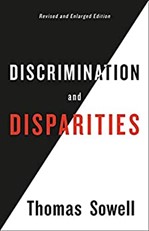 In the media, there is more heat than light. How do I understand the issues without the heat, the accusations, the emotional noise of it all?
In the media, there is more heat than light. How do I understand the issues without the heat, the accusations, the emotional noise of it all?
History always moves in cycles—repeats itself with variations—but the themes over time are consistent. I love the work of Thomas Sowell. He is a historical demographer, and he looks at patterns over time. As the old adage goes, “The person who does not understand history is doomed to repeat it.”
In this book, Sowell makes a key distinction between discrimination and disparities. He makes the point that disparities have always and will always exist. (Disparities are about outcomes.) For example, eldest children and only children are disproportionally represented in leadership positions. Is that fact discrimination or a disparity?
In my opinion, the concept of discrimination is best understood in an interview between Michael Parkinson and Muhammad Ali. Ali says he once asked his mother, “Mother, how come is everything white?” Ali was heavyweight champion of the world, but he could not get served at a restaurant because of his color. But he was also a disparity because out of all the people in heavyweight boxing, he became heavyweight champion of the world.
If you want to have more light than heat in understanding current issues, this is a book for you.
 Bowen Theory is the understanding of the emotional systems that exist in nuclear families. Unbeknownst to each of us, we carry these unspoken emotional systems with us into other situations and society at large.
Bowen Theory is the understanding of the emotional systems that exist in nuclear families. Unbeknownst to each of us, we carry these unspoken emotional systems with us into other situations and society at large.
In marriage or commitment to one another, there is a “fusion of emotional oneness.” This becomes a lifestyle and predicts a couple’s future problems.
In this “spectrum” of fusion, the following mechanisms are used: “emotional distance, marital conflict, sickness or dysfunction in one spouse, or projection of the problems to the children.”
The emotional system is evidenced by “the movement of anxiety.” One person in the system reacts, and it impacts everyone in that system. “Anxiety is infectious.”
Anxiety in relationships shows up in four different patterns: (a) triangling, (b) conflict, (c) distance, and (d) over-functioning or under-functioning reciprocity (dysfunctional spouse).
I was particularly interested in the emotional “cutoff,” which is an extreme form of distancing. You are out of the tribe. Also, these emotional patterns are passed intergenerationally.
It was fascinating for me to read because I saw several of these patterns in my own family, in other families I have known, and in organizational “families.”








